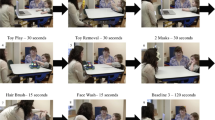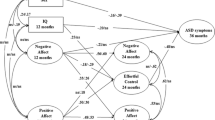Abstract
Research on the expression of positive affect in young children with Autism Spectrum Disorder (ASD) suggests that differences in this domain emerge late in the first year or early in the second year. However, many previous studies in this area employed retrospective research methods and global rating schemes. In the current study, the expression of positive affect was examined prospectively at ages 6, 12, and 18 months in three groups: infant siblings with ASD, infant siblings without ASD, and low-risk comparison infants. Infant siblings were the younger brothers or sisters of children diagnosed with ASD and, therefore, had a higher familial risk of ASD. The frequency and duration of smiles were coded from video excerpts from the Autism Observation Scale for Infants (Bryson, Zwaigenbaum, McDermott, Rombough, and Brian 2008), a standardized, play-based assessment of early signs of ASD. Results indicated that at 12 months, infant siblings with ASD had a lower rate of smiling than the other two groups. At 18 months, infant siblings with ASD continued to display a lower rate of smiling than infant siblings without ASD, but not comparison infants. Overall, these results indicate that infant siblings with ASD demonstrate less positive affect than infant siblings without ASD and low-risk comparison infants at 12 months. This suggests that reduced smiling may be an informative behavioural risk marker for ASD by children’s first birthdays and may have implications for our understanding of atypical social development in children with ASD.


Similar content being viewed by others
References
Adrien, J. L., Perrot, A. A., Hameury, L. L., & Martineau, J. J. (1991). Family home movies: Identification of early autistic signs in infants later diagnosed as autistics. Brain Dysfunction, 4, 355–362.
Adrien, J. L., Lenoir, P., Martineau, J., & Perrot, A. (1993). Blind ratings of early symptoms of autism based upon family home movies. Journal of the American Academy of Child and Adolescent Psychiatry, 32, 617–626. doi:10.1097/00004583-199305000-00019.
American Psychiatric Association. (2000). Diagnostic and statistical manual of mental disorders (4th ed., text rev.). Washington: American Psychiatric Association.
American Psychiatric Association. (2013). Diagnostic and statistical manual of mental disorders (5th ed.). Washington: American Psychiatric Association.
Baranek, G. T. (1999). Autism during infancy: A retrospective video analysis of sensory-motor and social behaviors at 9–12 months of age. Journal of Autism and Developmental Disorders, 29, 213–224. doi:10.1023/A:1023080005650.
Bryson, S. E., Zwaigenbaum, L., Brian, J., Roberts, W., Szatmari, P., Rombough, V., et al. (2007). A prospective case series of high-risk infants who developed autism. Journal of Autism and Developmental Disorders, 37, 12–24. doi:10.1007/s10803-006-0328-2.
Bryson, S. E., Zwaigenbaum, L., McDermott, C., Rombough, V., & Brian, J. (2008). The Autism observation scale for infants: Scale development and reliability data. Journal of Autism and Developmental Disorders, 38, 731–738. doi:10.1007/s10803-007-0440-y.
Cassidy, J., & Shaver, P. R. (2008). Handbook of attachment: Theory, research, and clinical applications (2nd ed.). New York: Guilford Press.
Dawson, G., Osterling, J., Meltzoff, A. N., & Kuhl, P. (2000). Case study of the development of an infant with autism from birth to two years of age. Journal of Applied Developmental Psychology, 21, 299–313. doi:10.1016/S0193-3973(99)00042-8.
Development Core Team, R. (2011). R: A Language and Environment for Statistical Computing. Vienna: R Foundation for Statistical Computing.
Ekman, P., & Friesen, W. V. (1978). Facial action coding system: Investigator’s guide. Palo Alto: Consulting Psychologists Press.
Garon, N., Bryson, S. E., Zwaigenbaum, L., Smith, I. M., Brian, J., Roberts, W., et al. (2009). Temperament and its relationship to autistic symptoms in a high-risk infant sib cohort. Journal of Abnormal Child Psychology, 37, 59–78. doi:10.1007/s10802-008-9258-0.
Georgiades, S., Szatmari, P., Zwaigenbaum, L., Bryson, S., Brian, J., Roberts, W., et al. (2013). A prospective study of autistic-like traits in unaffected siblings of probands with autism spectrum disorder. Journal of the American Medical Association Psychiatry, 70, 42–48.
Landa, R. J. (2011). Developmental features and trajectories associated with autism spectrum disorders in infants and toddlers. In D. G. Amaral, G. Dawson, & D. H. Geschwind (Eds.), Autism Spectrum Disorders (pp. 213–228). New York: Oxford University Press.
Landa, R. J., Holman, K. C., & Garrett-Mayer, E. (2007). Social and communication development in toddlers with early and later diagnosis of autism spectrum disorders. Archives of General Psychiatry, 64, 853–864.
Lawrence, M.A. (2010). EZ does it: Statistical programming for non-programmers. Poster session presented at the Annual Meeting of the Society for Computers in Psychology, St. Louis, MO.
Lawrence, M. A., & Klein, R. M. (2012). Isolating exogenous and endogenous modes of temporal attention. Journal of Experimental Psychology: General. doi:10.1037/a0029023.
Lord, C., Rutter, M., & Le Couteur, A. (1994). Autism diagnostic interview—Revised: A revised version of a diagnostic interview for caregivers of individuals with possible pervasive developmental disorders. Journal of Autism and Developmental Disorders, 24, 659–685. doi:10.1007/BF02172145.
Lord, C., Risi, S., Lambrecht, L., Cook, E. R., Leventhal, B. L., DiLavore, P. C., et al. (2000). The Autism diagnostic observation schedule—Generic: A standard measure of social and communication deficits associated with the spectrum of autism. Journal of Autism and Developmental Disorders, 30, 205–223. doi:10.1023/A:1005592401947.
Maestro, S., Muratori, F., Barbieri, F., Casella, C., Cattaneo, V., Cavallaro, M., et al. (2001). Early behavioral development in autistic children: The first 2 years of life through home movies. Psychopathology, 34, 147–152. doi:10.1159/000049298.
Maestro, S., Muratori, F., Cavallaro, M., Pei, F., Stern, D., Golse, B., et al. (2002). Attentional skills during the first 6 months of age in autism spectrum disorder. Journal of the American Academy of Child and Adolescent Psychiatry, 41, 1239–1245. doi:10.1097/00004583-200210000-00014.
Maestro, S., Muratori, F., Cavallaro, M., Pecini, C., Cesari, A., Paziente, A., et al. (2005). How young children treat objects and people: An empirical study of the first year of life in autism. Child Psychiatry and Human Development, 35, 383–396. doi:10.1007/s10578-005-2695-x.
McGrath, P. A., de Veber, L. L., & Hearn, M. T. (1985). Multidimensional pain assessment in children. In H. L. Fields, R. Dubner, & F. Cervero (Eds.), Advances in pain research and therapy (Vol. 9, pp. 387–393). New York: Raven Press.
Moore, C. (2006). The development of commonsense psychology. New York: Psychology Press.
Nichols, C., Ibañez, L. V., Foss-Feig, J. H., & Stone, W. L. (2014). Social smiling and its components in high-risk infant siblings without later ASD symptomatology. Journal of Autism and Developmental Disorders, 44, 894–902. doi:10.1007/s10803-013-1944-2.
Ozonoff, S., Losif, A., Baguio, F., Cook, I. C., Hill, M., Hutman, T., et al. (2010). A prospective study of the emergence of early behavioral signs of autism. Journal of the American Academy of Child and Adolescent Psychiatry, 49, 256–266. doi:10.1097/00004583-201003000-00009.
Rothbart, M., & Bates, J. (1998). Temperament. In W. Damon & N. Eisenberg (Eds.), Handbook of child psychology: Vol. 3, social, emotional, and personality development (5th ed., pp. 105–176). New York: Wiley.
Royall, R. (1997). Statistical evidence: A likelihood paradigm. Boca Raton: Chapman and Hall.
Rutherford, M. D. (2005). A retrospective journal-based case study of an infant with autism and his twin. Neurocase, 11, 129–137. doi:10.1080/13554790590925529.
Sroufe, L., & Waters, E. (1976). The ontogenesis of smiling and laughter: A perspective on the organization of development in infancy. Psychological Review, 83, 173–189. doi:10.1037/0033-295X.83.3.173.
Vacha-Haase, T., Nilsson, J. E., Reetz, D. R., Lance, T. S., & Thompson, B. (2000). Reporting practices and APA editorial policies regarding statistical significance and effect size. Theory & Psychology, 10, 413–425. doi:10.1177/0959354300103006.
Vallotton, C. D. (2009). Do infants influence their quality of care? Infants’ communicative gestures predict caregivers’ responsiveness. Infant Behavior & Development, 32, 351–365. doi:10.1016/j.infbeh.2009.06.001.
Werner, E., Dawson, G., Osterling, J., & Dinno, N. (2000). Brief report: Recognition of autism spectrum disorder before one year of age: A retrospective study based on home videotapes. Journal of Autism and Developmental Disorders, 30, 157–162. doi:10.1023/A:1005463707029.
Wu, L. (2010). Mixed effects models for complex data. Boca Raton: Chapman and Hall.
Zwaigenbaum, L. (2011). Screening, risk, and early identification of autism spectrum disorders. In D. G. Amaral, G. Dawson, & D. H. Geschwind (Eds.), Autism spectrum disorders (pp. 75–89). New York: Oxford University Press.
Zwaigenbaum, L., Bryson, S., Rogers, T., Roberts, W., Brian, J., & Szatmari, P. (2005). Behavioral manifestations of autism in the first year of life. International Journal of Developmental Neuroscience, 23, 143–152. doi:10.1016/j.ijdevneu.2004.05.001.
Zwaigenbaum, L., Thurm, A., Stone, W., Baranek, G., Bryson, S., Iverson, J., et al. (2007). Studying the emergence of autism spectrum disorders in high-risk infants: Methodological and practical issues. Journal of Autism and Developmental Disorders, 37, 466–480. doi:10.1007/s10803-006-0179-x.
Acknowledgments
This research was supported by grants from the Canadian Institutes of Health Research (CIHR) and Autism Speaks Canada. During the course of this project, Jillian Filliter was supported by funding from the Killam Trusts and the Natural Sciences and Engineering Research Council of Canada, as well as an Autism Speaks Dennis Weatherstone Predoctoral Fellowship (#7427). She was also a trainee of the CIHR-funded Autism Research Training Program. Lonnie Zwaigenbaum holds the Stollery Children’s Hospital Foundation Chair in Autism Research and is supported by an Alberta Innovates - Health Solutions Health Scholar Award. Isabel Smith holds the Joan and Jack Craig Chair in Autism Research at Dalhousie University; Susan Bryson held the Craig Chair during the period in which the study was conducted. We would like to thank the Infant Sibling Study and Autism Research Centre staff (including Theresa McCormick, Jessica Soley, Vickie Armstrong, Jillian Boyd, Megan Fisher, and Samantha Chaulk), as well as the families who have participated in our infant sibling research, for their ongoing dedication to this work.
Conflict of Interest
The authors declare that they have no conflict of interest.
Author information
Authors and Affiliations
Corresponding author
Rights and permissions
About this article
Cite this article
Filliter, J.H., Longard, J., Lawrence, M.A. et al. Positive Affect in Infant Siblings of Children Diagnosed with Autism Spectrum Disorder. J Abnorm Child Psychol 43, 567–575 (2015). https://doi.org/10.1007/s10802-014-9921-6
Published:
Issue Date:
DOI: https://doi.org/10.1007/s10802-014-9921-6




